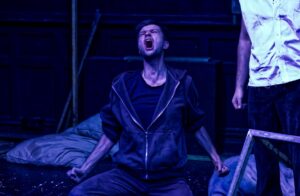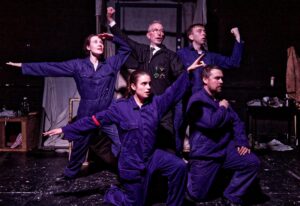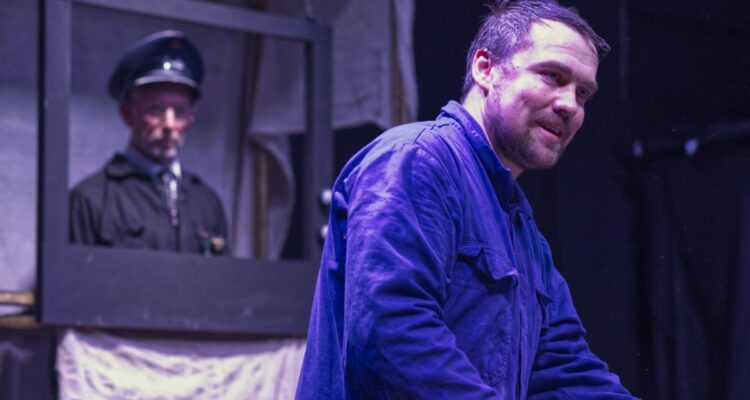As a North Londoner, I rarely cross the River Thames, but I was glad to find myself in a cool (and slightly grunge) Brixton pub, which gladly accepted tourists off the street to take a seat in their 50-person back-room theatre.
The consecutive George Orwell inspired plays allowed for an interval of around 20 minutes, before we were again ushered into the theatre, to sit where we please, always at most 2 feet from the stage.
Animal Farm

was performed by an all-male 5-person cast, who adopted many roles (human, animal and pig) throughout the play, and cleverly handled sacks and pillows to artificially grow the cast to include birds. The use of physical theatre, combined with voice acting, allowed the animals to come to life without extravagant costumes. I was particularly surprised as I felt for the poor horse Boxer and resented the pig Napoleon, displaying how well the actors brought the animal kingdom to life. The play stuck to the original plot, and the audience was constantly reminded about the metaphors behind the play, the constraints of populism and communism.
George Orwell’s book, Animal Farm, was adapted into a play (masterfully by Paul Stebbings). He tells the story of a drunken Farmer, whose animals decide that a rebellion is needed, so that they no longer are overworked and poorly fed, without enjoying the fruits of their labour. Humans are the enemy, who not only enjoy their produce, but decide their work hours and execute them for their own profit. At first, Animal Farm is a communist ideal, in which everyone can work, and the human farmers are overturned. However, the disparity in intelligence amongst the animals allows for the pigs to rise above other animals, resulting in the dictator Napoleon. Napoleon slowly becomes more human, wearing clothes and dealing with the enemy, humankind.
1984

1984 on the other hand, is a story about a hyper-surveillance police state. Winston, a worker in the Ministry of Truth (in which he ‘edits’ newspapers to remove free press) secretly knows the evil of the ‘Big Brother’ and the endless wars fought. He finds love with another dissident of the state and, after rebelliously forming a relationship, they are convinced to attend a ‘resistance meeting’. This was however a trap and the two are sent to a prison and a confession is forced from Winston.
The play begins with the torture that brought about his confession and the entire story is told through Winston’s lens which has been broadcasted on state television.
1984 was acted by only one of the same actors that played a cow in Animal Farm (Jack Herlihy) , but the four new actors had to perform a quick turnaround in the interval. The performance was done brilliantly, and the whole space was used by the actors, to give the effect that you were amongst Big Brother’s evil eye. The play allowed for harsh internal reflection, as we now live in a world of talking TVs and Amazon devices.
The set for both consisted of wooden planks and metal bars that were engineered to created bunk beds, a windmill and many other dynamic sets that were quickly formed by the actors on stage to allow for speedy scene changes. The props were simple: sheets and pillows, but the actors performed excellently to bring these to life.
I really enjoyed both plays and I would award them both a five-star rating.
Animal Farm Cast
Tony Wadham – Boxer/Old Major
Gerald Dorrity – Snowball/Whymper/Goose
Bastian Tyrko – Dog/Squealer
Jack Herlihy – Farmer Jones/Cow/Crow
Janeks Babidorics – Napoleon
Animal Farm Creative Team
Gaspard Legendre – Director
Paul Stebbings – Writer
John Kenny – Music
Emily Mills – Lighting and Sound
1984 Cast
Jack Herlihy – Winston Smith
Ellen Victoria – Julia
Bruno Roubicek – O’Brien
Tom Vercnocke – Parsons/Charrington
Avena Mansergh-Wallace – Mavis/Prostitute/Washerwoman
1984 Creative Team
Paul Stebbings – Director
Paul Stebbings and Phil Smith – Writers
Christian Auer – Music and Sound Score
Emily Mills – Lighting and Sound

